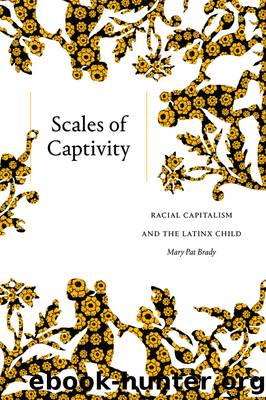Scales of Captivity by Mary Pat Brady

Author:Mary Pat Brady
Language: eng
Format: epub
Publisher: Duke University Press
The movement of capital is registered here as a changing relationship to the nearby. This kind of engagement with the valley bespeaks a sense of relationship with a place, an acknowledgment of place as enmeshed in sociality and not simply a notch on a vertical hierarchy where real living happens elsewhere. Individuals, the stories teach, are not outside of places; they are not apart from the âdense materialities that compose sites,â nor are they the âtranscendental author of those sites.â 69
This sense of people and place as interanimating does not give much room to a social imaginary that isolates individual actors with heroic coming-out accounts. Instead, The Faith Healer of Olive Avenue highlights a set of intermeshed relations far more in sync with Mary Grayâs argument in Out in the Country . There Gray persuasively shows how the politics of visibility that has emerged as a product of the contemporary gay rights movement depends for its political utility on urban living. Visibility and the closet therefore are inadequate metaphors for approaching an understanding of nonurban queer cultures. As she argues, âAt the moment, queer desires and embodiments are popularly and politically tethered to prescriptions of exacting kinds of LBGT visibility. These politics and practices, however, fail to recognize the price rural LGBT -identifying youth pay for this âclaustrophilia.â â 70 Understanding queer cultures beyond urban locales entails refusing the normalizing mechanisms of queer visibility and assembling such a sensibility via other mechanisms and technologies. Gray suggests that rural queer youth âconstantly reworked boundariesâ without queer visibility as the normative or utopian end marker. 71 In rejecting the universality of visibility politics, Gray shifts the focus âaway from the private world of individual negotiations of the closetâ so that we learn how queer identities can be understood as âcollective laborâ and as âwork shared among many rather than the play of any one individual.â 72 That many includes place and the complex of relationships among beings (including orange trees and lizards).
Three stories in The Faith Healer of Olive Avenue in particular illustrate Grayâs concept of collaborative labor by suggesting that what characters move toward is not a named identity but rather a sense of living and working together, collaboratively pursuing fulfillment or survival. The stories show that such mutuality entails a carefully wrought series of negotiations in which many characters labor together to find room for each otherâs approaches to living, carefully acknowledging, in keeping with the collectionâs interest in empathy, how bodies in motion and materialities have an impact on each other. Put differently, to understand queer identity as a collective labor is also to understand how dense relations emerge from indebtedness, from a knowledge of responsibility and shared vulnerability. To see identity as collaborative is to undo the individuating logic of market capitalism. The scaffold imaginary doesnât have any leeway for collaboration.
In âBring, Brang, Brung,â the narrative follows Mart à n after he has reluctantly returned to his hometown in âthe Valley.â A single father whose lover has recently
Download
This site does not store any files on its server. We only index and link to content provided by other sites. Please contact the content providers to delete copyright contents if any and email us, we'll remove relevant links or contents immediately.
4 3 2 1: A Novel by Paul Auster(11788)
The handmaid's tale by Margaret Atwood(7447)
Giovanni's Room by James Baldwin(6808)
Asking the Right Questions: A Guide to Critical Thinking by M. Neil Browne & Stuart M. Keeley(5355)
Big Magic: Creative Living Beyond Fear by Elizabeth Gilbert(5351)
Ego Is the Enemy by Ryan Holiday(4956)
On Writing A Memoir of the Craft by Stephen King(4662)
The Body: A Guide for Occupants by Bill Bryson(4580)
Ken Follett - World without end by Ken Follett(4443)
Bluets by Maggie Nelson(4261)
Adulting by Kelly Williams Brown(4232)
Eat That Frog! by Brian Tracy(4149)
Guilty Pleasures by Laurell K Hamilton(4116)
White Noise - A Novel by Don DeLillo(3829)
The Poetry of Pablo Neruda by Pablo Neruda(3814)
Fingerprints of the Gods by Graham Hancock(3735)
Alive: The Story of the Andes Survivors by Piers Paul Read(3730)
The Book of Joy by Dalai Lama(3697)
The Bookshop by Penelope Fitzgerald(3619)
